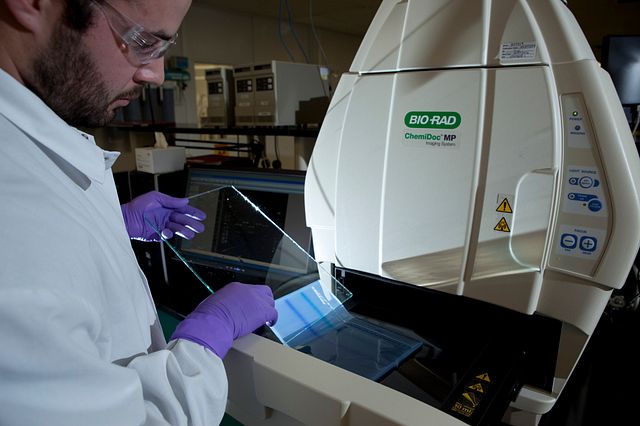Cell Line Authentication and Characterization Methods
Cell line characterization is performed for Master Cell Banks (MCB), Working Cell Banks (WCB), and End-of-Production Cells (EPC) or cells at the limit (CAL) of in vitro cell age used for production.
According to current regulations, the following aspects must be considered:
- The origin and history of the cell line cellular morphology and growth characteristics
- Cellular identity
- Purity of the cell lines (i.e., absence of contaminating cells, microbial contaminations, and contaminations by adventitious viruses)
- Tumorigenicity and oncogenicity
- Genetic Stability
Cell Line Authentication Package Recommendations
Considerations include species of the cell line (e.g., hamster, human, chicken, E. coli, P. pastoris) and its intended use (e.g., recombinant protein production, vaccine production, gene therapy). Furthermore, documentation of the source of the cell line and its development history, as well as the biological properties of the cells, determines which testing should be performed. When executing the assays, the guidelines recommend using testing procedures that are validated to show their suitability for the intended purpose.
Microbial, Mammalian, & CHO Cell Line Authentication Methods
The tables below list recommended testing plans for general mammalian, microbial, and CHO cell line characterization to produce a recombinant protein.
-
Mammalian Cell Line Characterization
Mammalian Cell line Characterization Panel1 MCB WCB EPC/CAL Microbial Contamination Sterility X X X Mycoplasma X X X Mycobacterium X Spiroplasma X Cell Line Identity DNA Barcoding X X X DNA fingerprinting/STR X X Karyology X X Genetic stability DNA sequencing X Optional Gene copy number by qPCR/STR X X Virus Testing Retroviruses: Reverse transcriptase and retroviral infectivity assays X X In vitro adventitious viruses X X X In vivo adventitious viruses X X Test for specific viruses such as:
- Bovine viruses
- Porcine viruses
- Human viruses
- Minute virus of mice
X In vivo biosafety: Mouse, hamster, and rat antibody production assays (MAP, RAP, and HAP) X Transmission electron microscopy X X Tumorigenicity/Oncogenicity X 1Novel molecular methods based on next generation sequencing (NGS) technology can also be offered to supplement the test program.
-
Microbial Cell Line Characterization
Microbial Cell Line Characterization Panel MCB WCB Bacteriophage detection X X Purity X X Identification X X Viability X X Copy number X X DNA Sequencing X X Retention of selectable markers X X Retention of recombinant construct X X Restriction Endonuclease Analysis X X -
CHO Cell Line Characterization
CHO Cell line Characterization Panel MCB WCB EPC/CAL Microbial Contamination Sterility X X X Mycoplasma X X X Cell Line Identity DNA Barcoding X X X Genetic stability DNA sequencing X X Gene copy number X X Restriction endonuclease analysis X X Virus Testing Endogenous and non-endogenous retroviruses: reverse transcriptase and retroviral infectivity assays X X In vitro adventitious viruses X X In vivo adventitious viruses (suckling and adult mice, embryonated eggs) X X Test for specific viruses such as:
- Bovine viruses
- Porcine viruses
- Minute virus of mice
X In vivo biosafety: Mouse and hamster antibody production assays (MAP and HAP) X Transmission electron microscopy X X
Validated methods for mammalian and microbial cell line characterization are available at our sites in both the United States and Europe. References to guidelines concerning cell line characterization can be found in our regulatory library.
With all of these things to consider, it is important to determine not only the most effective, but also the most relevant and efficient cell line authentication plan for you.
Frequently Asked Questions (FAQs) for Cell Line Characterization:
-
Why is cell line characterization important?
Cell line characterization is critical to the control of biological product manufacturing. The objective of the testing is to confirm the identity, purity, and suitability of the cell substrate for manufacturing use. The specific strategy of testing to characterize a cell bank varies based on several factors including, but not limited to, the source of the cell line itself, its growth requirements, and cultivation history.
-
What is cell line authentication?
Proper cell line authentication is crucial to assure that inadvertent contamination of cell lines has not occurred during the regular cell culturing work. It is particularly important to authenticate the identity and characteristics of a cell line during the drug development process to verify that the parent cell line is maintained while monitoring the effects of new therapeutics on a particular cell line.
-
What are the regulatory requirements for cell line characterization?
Several factors must be taken into consideration in terms of regulatory requirements, such as the product type, the cell line is being used to manufacture (e.g., antibody, viral vaccine, etc.), and the geographic region where the sponsor intends to seek commercial licensure (e.g., US, EU, Japan, etc.).
Examples of guidance documents from various regulatory authorities that may be useful include the 1993 Points to Consider in the Characterization of Cell Lines Used to Produce Biologicals (FDA), the 2010 Guidance for Industry for Characterization and Qualification of Cell Substrates and Other Biological Materials Used in the Production of Viral Vaccines for Infectious Disease Indications (FDA), and the ICH Q5 series (specifically Q5A, Q5B, and Q5D).

